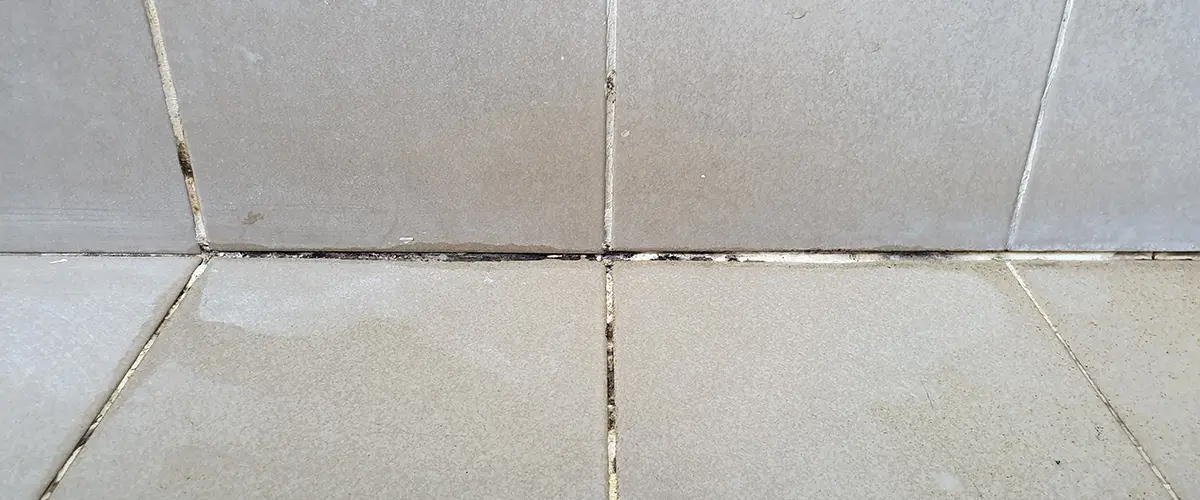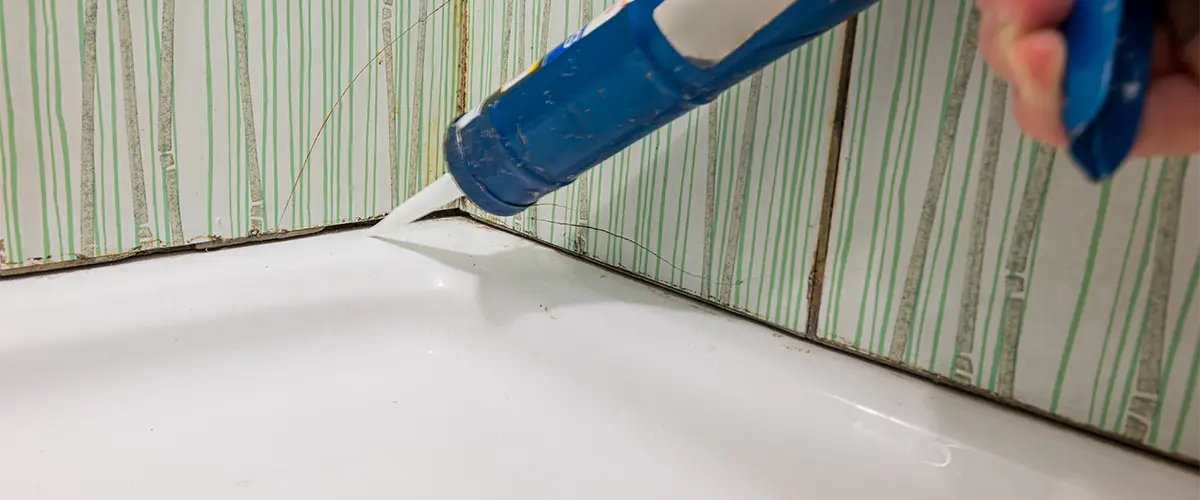Before remodeling any kitchen or bathroom, caulking and grouting are two of the most important aspects. Each is used to fill in between tiling; however, each has its own advantages, and using the incorrect one can lead to expensive mistakes further down the line.
Experts frequently rely on adhesives to guarantee top-notch, long-lasting results in tiling projects. The contention between caulk and grout is a constant battle regarding redesign.
A crucial distinction to make: grout and caulk have varied applications. Let’s uncover the reasons that set them apart and identify which one is most appropriate for each situation!

What Is Caulk
Caulk is an essential adhesive to seal the gaps between tiles and other surfaces, like glass. This dynamic compound can be composed of latex, silicone, or acrylic, rendering it malleable yet resistant to minimal movement. It’s most commonly used where the shower wall meets the tub or floor.
Sealing compounds are essential to any building or structure, providing a barrier against water infiltration (giving it a waterproof seal), air leakage, dust particles, and insects. They can also be used as part of firestop systems for added protection.
Ensuring the area below your bathtub is dry and preventing dampness can be easily achieved by applying sanded caulk or clear silicone on wet areas. This proactive measure decreases the risk of mold, which in turn helps protect you and your family’s health.
To ensure your wall is safe from water damage, caulk should always be applied to seal the spaces between new tiles. Remember that it shrinks and contracts over time so use caution when tackling larger projects. The good thing about using caulk instead of grout is that it won’t crack as grout does!
Uses For Caulk
Caulk is a multi-purpose product that can be used in both interior and exterior spaces. Let’s explore some of the best places to apply caulk:
- Caulk is great for sealing off bugs and other pests.
- Experts use caulk for sealing cracks in metal, brick, or stone.
- Sealing wood keeps termites away from the wood interior, and this adhesive gets the job done fast and easily.
- Waterproof silicone caulk is ideal for keeping your walls safe from mold. Besides, this caulk is mildew resistant and forms a durable, watertight seal.
- The painter's caulk dries quickly, making it ideal for quick fixes before painting a surface.
- Fireproof caulk seals gaps or holes. This product prevents fire from moving through an open space within a structure.
Application Of Caulk Lines
Before caulking, the walls must be thoroughly cleaned and dried for top results. The correct caulk gun should also be obtained by professionals for successful application.
But there’s more to this.
Here are some tricks professionals do to get the best caulking job.
- Clean the spout with a screw. If you're using a caulk tube already opened, I can guarantee a plug formed in the tip, and the caulk won't come out as it should. Use a screw to clean the tip, and you're good to go.
- Tape your walls before caulking. This is super useful because it helps you control the caulk. After you've finished, smooth it out with your finger and remove the tape.
- Push the caulk, don't pull. Try as much as possible to push the caulk into every gap. You want to fill in every little hole, so removing the caulk outwards will not work in your favor.
- Cut the tip straight. Although cutting at an angle works OK in some cases, a straight tip provides more control and accuracy. Ensure you don't cut too much from the tip. Start with a small 1/16 in. in diameter, and adjust it when you need to.
- Don't use your wrists. Use your upper body and legs to move the caulking gun up and down, not your wrists.
- Avoid making globs. Continuing a bead after you've stopped is hard and can turn out ugly. If you have a long line, you have to caulk, start from one end to the middle, and then continue from the other end until the lines meet.

What Is Grout
Grouting your tiles is the key to completing any tiling job. Selecting a tile grout that complements and enhances your tiles is essential for achieving an attractive, aesthetically-pleasing outcome.
The Ceramic Tile Institute of America states that colored grout is a unique blend of finely-graded aggregate, Portland cement, water-dispersing agents, plasticizers, and colorfast pigments.
To guarantee a successful tiling project, blend grout with fine gravel and apply it at plane angles, along angled seams or anywhere the shower wall adjoins tile flooring.
Uses For Grout
- When it comes to flooring, sanded grout is the ultimate pick. This cement-based material blended with sand provides unsurpassable stability for any tiles bigger than 1/8 inches wide. Sanded grout makes sure your floor will look flawless and last!
- Since unsanded grout has no aggregate, it is much stickier and more difficult to work with. However, if your grout joints are 1/8" wide or less, then use this type of material for best results.
- Epoxy grout is the most reliable option for longevity and stain resistance, particularly in areas of your home with high foot traffic, such as kitchens and bathrooms. This type of grout is also commonly utilized to fill joints on a tile shower floor by professional installers!
Application of Grout Lines
Once the tile surfaces are installed, and any adhesive used has had ample time to dry, new grout should be applied. The drying period will vary depending on the type of adhesive chosen – make sure to read all product instructions carefully before beginning this process. Be sure to take extra care in eliminating existing grout lines for a fresh start!
To evenly distribute the mixture over the tiles, use a grout float and angle it to 45 degrees. Work your way into each joint between tiles until you have completely covered all of them.
For a seamless finish, wipe away any excess grout with a damp rag or sponge while you move toward the completion of your tiling task. Postponing cleaning up is not an option; drying grout can be quite arduous!
After the tiling job is finished, use a grout protector spray to fortify your grout lines and maintain them in pristine condition. This is particularly essential for bathrooms and kitchens where water, oil, grease, and dirt can make it difficult to keep clean without proper protection.

Using Grout And Caulk
Unlike grout, caulk’s elasticity makes it a superior material for binding two disparate materials, such as tiles and glass. Whether you’re joining ceramic to Plexiglas or cement walls to concrete floors, caulk is the glue that keeps these pieces together with a secure bond.
Grout is necessary for tiling, as it needs to be inserted into the crevices between tiles. Its purpose is not only aesthetic — grout adds stability and strength to your tile installation by preventing any edges or corners from cracking or breaking. Make sure you take care when cleaning around grout lines because scratching can cause damage that will weaken its structure.
Grout is ideal for tiling projects, such as shower walls, wall tiles, and tile joints. For bigger gaps and holes or to fill in spaces between different materials on other surfaces, caulk proves its usefulness over grout. It’s an easy solution that provides a great seal with minimal effort!
Grout and caulk exist in various shades, allowing you to easily marry your tiles. Although colored grouts might be a bit more costly than plain varieties, they are worth the extra buck!
Conclusion
Be it caulk or grout, you need both, but for different reasons.
Even the most minute details in your bathroom can make a big difference. The grout and caulk from your tiles, tub or shower, are key components that can add to its beauty when done correctly.
For the tiles in areas where mold can easily form, grout is essential to ensure that it remains slip-proof and sealed. Mold is a serious problem in many bathrooms that cause a lot of health problems.
Check out this CDC article about mold and how to prevent it.
Additionally, good quality grout will also resist staining and guard against mould and mildew growth. These two materials are key for any space prone to moisture accumulation!
At JN Tiling And Construction, we know everything there is to know about bathroom remodels and tiling. We’re professionals in our industry and go above and beyond to see you fully satisfied. Get us on your tile projects for the best tile installations in Northeast Indiana!
Call us today at (260) 316-4537 and let JN Tiling And Construction pros handle your tiling project!

